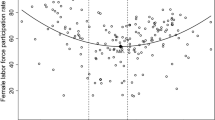Abstract
This paper examines the issue of global child labor. The treatment is grounded in the classical economics of Adam smith and the more recent writings of human capital theorists. Using this framework, the universal problem of child labor in newly industrializing countries is investigated. Child labor is placed in its historical context with a brief review of practices in the United States and Great Britain at the time those countries were industrializing. Then, child labor is examined in its contemporary global context. We argue that, as countries industrialize, they tend to follow predictable patterns of development – including use of and eventual abandonment of child labor. We argue that this convergence under the logic of industrial capitalism supports a universalist approach to human rights (that would condemn child labor) over a more tolerant cultural relativist approach.
Similar content being viewed by others
References
Bartlett, Christopher A. and Sumantra Ghoshal: 1991, Managing Across Borders: The Transnational Solution (Harvard Business School Press, Boston MA).
Bator, F. M.: 1957, ‘The Simple Analytic of Welfare Maximization’ American Economic Review 47, 22–59.
Black, Maggie: 1995, In the Twilight Zone: Children in the Hotel, Tourism and Catering Industry (Geneva, ILO).
Donaldson, Thomas: 1989, The Ethics of International Business (Oxford University Press, NY).
Fuller, Raymond G.: 1922, The Meaning of Child Labor (A.C. McClure & Co., Chicago).
Hamilton, Alexander: 1791, ‘Report on Manufactures’ in Samuel McKee (ed.), Papers on Public Credit, Commerce and Finance (The Liberal Arts Press, NY), 1957, pp. 175–276.
ILO: 1995, ‘Governing Body Document on Child Labour: Committee on Employment and Social Policy’ (GB.264/ESP/1).
ILO: 1997, Child Labour: Targeting the Intolerable (Geneva).
Kerr, Clark, John T. Dunlop, Frederick H. Harbison and Charles A. Myers: 1960, Industrialism and Industrial Man (Harvard University Press, Cambridge MA).
Kindleberger, C. P. and B. Herrick: 1977, Economic Development, 3rd Edition (McGraw-Hill, New York).
Marvel, Howard P.: 1977, ‘Factory Regulation: A Reinterpretation of Early English Experience’ The Journal of Law and Economics 20(2) (Oct), 379–402.
Nardinelli, Clark: 1990, Child Labor and the Industrial Revolution (Indiana University Press, Bloomington).
Nichols, Martha: 1993, ‘Third-World Families at Work: Child Labor or Child Care?’ Harvard Business Review (Jan–Feb), #93105.
Parnes, Herbert S.: 1984, People Power: Elements of Human Resource Policy (Sage Publications, Beverly Hills CA).
Reich, Robert: 1991, The Work of Nations: Preparing Ourselves for 21st Century Capitalism (Vintage Books, New York).
Smith, Adam: 1776, An Inquiry into the Nature and Causes of the Wealth of Nations (Oxford University Press, Oxford, 1993).
Trattner, Walter I.: 1970, Crusade for the Children: A History of the National Child Labor Committee and Child Labor Reform in America (Quadrangle Books, Chicago).
UNICEF: 1997, State of the World's Children: 1997 (Oxford University Press, Oxford, UK).
U.S. Department of Labor: 1995, By the Sweat & Toil of Children (Vol. II): The Use of Child Labor in U.S. Agricultural Imports & Forced and Bonded Child Labor (Washington, Bureau of International Labor Affairs).
U.S. Department of Labor: 1996, The Apparel Industry and Codes of Conduct: A Solution to the International Child Labor Problem? (Washington, Bureau of International Labor Affairs).
U.S. General Accounting Office: 1992, Child Labor: Information on Federal Enforcement Efforts (HRD–92–127FS).
Ure, Andrew: 1835, The Philosophy of Manufactures (Frank Cass, London, 1967), p. 301.
Walters, Pamela B. and Carl M. Briggs: 1993, ‘The Family Economy, Child Labor, and Schooling: Evidence from the Early Twentieth-Century South’ American Sociological Review 58 (April), 163–181.
Author information
Authors and Affiliations
Rights and permissions
About this article
Cite this article
Hindman, H.D., Smith, C.G. Cross-Cultural Ethics and the Child Labor Problem. Journal of Business Ethics 19, 21–33 (1999). https://doi.org/10.1023/A:1006193721017
Issue Date:
DOI: https://doi.org/10.1023/A:1006193721017




